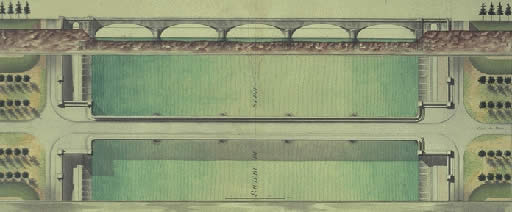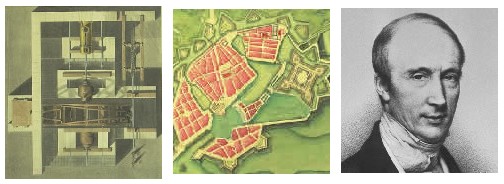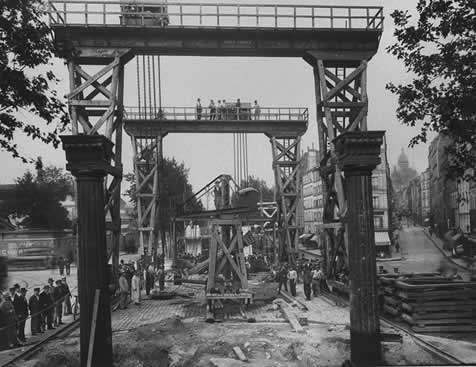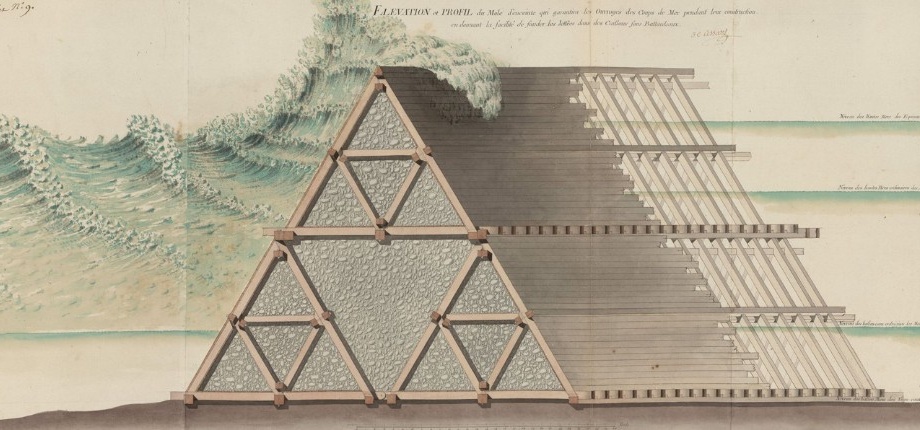The School in History
The Corps des Ponts et Chaussées (Bridges and Roads Corps) was created in 1716. In 1747, a decree issued by the King's Council, considered to be the founding act of the School, established a specific training program for state engineers, entrusted to Jean-Rodolphe Perronet. Between 1747 and the 21st century, the history of the School has been marked by the passage of great figures who have served the State through their research, their achievements, their atypical personalities, and their dedication. École nationale des ponts et chaussées has an extraordinary historical and cultural depth.
In France, the building of roads, bridges and canals was for a long time the sole prerogative of aristocrats, merchant associations or monastic orders. With Colbert, more effective policies emerged, but technicians were recruited on an ad hoc basis. It was not until 1716 that a properly appointed corps of engineers was created by royal order: the Corps des Ingénieurs des Ponts et Chaussées.
Fifty students
The introduction of a specific training programme for this corps was decided by the Royal Order of February 14, 1747, the School’s founding act. And until 1794, the School was marked by the personality of its director, Jean-Rodolphe Perronet, engineer, talented administrator and erudite scholar who contributed to the production of Alembert and Diderot’s Encyclopaedia. At this time, the School had around fifty students (Lebon, Bernardin de Saint-Pierre, Méchain, Brémontier…) and not one teacher. Indeed, the students taught themselves and each other to obtain a theoretical grounding in geometry, algebra, mechanics, hydraulics…

The theoretical instruction was underpinned by a fairly intense practical training through annual assignments to provincial construction sites or through collaborations with scientists and aristocrats. This practical aspect of the training was also reflected in the requirement on the students to take part in the mapping of the Kingdom.
Assessment was based on a number of factors: work rate, previous studies, outside courses, the annual assignments, classes taught and examination results. The period of study could therefore last from 4 to 12 years.
An applied school
The education gradually became structured and Ponts et Chaussées engineers steadily increased their prerogatives, obtaining a virtual monopoly over planning and development. With the Revolution, the authoritarian nature of this policy came under attack, and the idea emerged of creating a powerful school bringing together students from Ponts, Mines and Génie. The École Polytechnique thus came into being in 1795 and École des Ponts was retained as an applied school.

In 1798, Gaspard Riche de Prony took over as director. Until 1839, he concentrated on remodelling the old curricula to establish a rational link with the education received by students at Polytechnique.
This new École des Ponts got off to a somewhat tricky start, especially as the First Empire was a period of intense activity, marked by the rebuilding of the road network, which had deteriorated during the Revolution, and by a concentration on major hydraulics projects.
Famous engineers
Several engineers took part in the process: Barré de Saint-Venant, Belgrand, Biot, Cauchy, Coriolis, Dupuit, Fresnel, Gay-Lussac, Navier, Vicat. The pace of work increased, the complexity of the tasks grew and the School took some 20 years to adjust its education to the needs of the industrial era and to a more mobile society. In parallel, the year 1831 saw the creation of the School’s first laboratory and the first issue of the Annales des Ponts et Chaussées.
Marking a new phase in the evolution of the School, the Decree of 1851 emphasised the organisation of the courses, the establishment of an annual timetable, the quality of the teaching and the monitoring of student work. For the first time, the School opened its doors to external (French and foreign) and non-degree students. Because their educational level was lower than that of Polytechnique graduates, preparatory classes had to be created in 1875.?
At this time, in France, the remarkable development of transport, roads, bridges and canals… bears the strong imprint of engineers from the Ponts et Chaussées (Becquerel, Bienvenüe, Caquot, Carnot, Colson, Coyne, Freyssinet, Resal, Séjourné...). They modernised the country profoundly by creating the country’s much envied big transport networks.

Towards the end of the 19th century, the School had acquired its main distinctive features and underwent no more major upheavals. It simply adapted to the constant advances in techniques and created new teaching chairs: applied electricity, social economics, urbanism, air bases… However, the wars, the economic crisis of 1929 and the periods of Reconstruction were not favourable to the dynamic development of France’s great schools, and it was not until the post-war era that École des Ponts truly became a modern institution.
After the war, the School needed to be increasingly aware of the economic world. Staff numbers increased significantly to meet the growing demand for engineers, for both the state and private sectors. It was a period that really needed engineering skills (Ailleret, Galabru, Hirsch, Vicariot…): technical progress, the considerable advances in sciences and technologies relating to building, urban development and environmental protection, demanded greater curricular diversity, which radically changed the face of the School.

In 1983, the School began wide-ranging reforms in the recruitment of students, the structure of programmes, teaching methods, links with research and the business world, lifelong learning... Today, this lifelong learning section has become the largest of all the major engineering schools. In the same context, the School created a scientific and technical publishing house in order to contribute to the spread of French technologies and know-how. In parallel, although the research laboratory had separated from the School after the war, the need to link teaching and research re-emerged, and new research labs developed.
Public scientific, cultural and vocational institution
Having being officially declared a Scientific, Cultural and Professional Institution (EPSCP) on January 1, 1994, the School now had the right legal status to facilitate initiatives that would reflect the dynamism of its development. In 2000, under the direction of Pierre Veltz, the School introduced its most recent reform. Today, Ponts et Chaussées engineers have to be able to manage multidisciplinary projects. For this reason, the reform emphasised a strong scientific culture and fundamental specialist fields, for engineers trained to contribute to the resolution of complex sociotechnical problems and able to work in an international context.

In 2000, under the direction of Pierre Veltz, the School introduced its most recent reform. Today, Ponts et Chaussées engineers have to be able to manage multidisciplinary projects. For this reason, the reform emphasised a strong scientific culture and fundamental specialist fields, for engineers trained to contribute to the resolution of complex sociotechnical problems and able to work in an international context. This international dimension has been reinforced by the signature of new double-degree agreements.
The era of partnerships
In research, the creation of the Navier Institute in 2002 formed the basis for the establishment of a world ranking centre working in the field of structures and materials. However, despite continuous growth, the School is still too small to achieve the desired international impact on its own. Hence the crucial importance of mergers and partnerships, within the framework of the elite Parisian schools network, ParisTech, and the Cité Descartes network of higher education establishments, the Polytechnicum.
Launch of the Descartes+ project
This foundational role within local networks has deeply embedded the School in its new environment. In 2005, within the regional Sustainable Cities and Mobility competitiveness hub, the School and other Cité Descartes institutions launched the Descartes + project, the construction of a building able to produce its own energy.
Founder member of Paris-East University
In 2007, the School, along with Marne-la-Vallée University, was a founding member of Paris-East University, which integrates general, technological and vocational research and education into a single interdisciplinary whole.
In 2008, the School broke its last links with its past when it made the final move from Hôtel de Fleury. Only the associations, the subsidiaries and the Publishing Houses remain in Paris, at other addresses…
Descartes “centre of excellence” around a cluster associated with sustainable development. The aim of the Descartes Cluster is to become the future world reference centre for construction, maintenance and services for the sustainable city.
The Ministry in charge of Ecology and Sustainable Development and the Ministry of Higher Education and Research have jointly decided to create a world ranking scientific and technical hub at Paris-Vallée de la Marne, in the heart of Cité Descartes. Bringing IFSSTAR (Unviersité Gustave Eiffel) and CSTB together with the School in a new building named Bienvenüe is one of the elements of this plan.
Member of Institut Polytechnique de Paris
On July 15, 2024, decree 2024-818 confirmed the integration of the École nationale des ponts et chaussées into the Institut Polytechnique de Paris, joining 5 prestigious French engineering schools (École polytechnique, ENSTA, ENSAE Paris, Télécom Paris, Télécom SudParis) within this world-class science and technology institute.
This collaboration federates our research activities and enables us to pool our resources, a real asset for our socio-economic partners, by boosting our visibility and international competitiveness.

